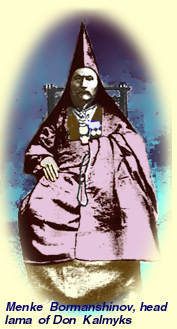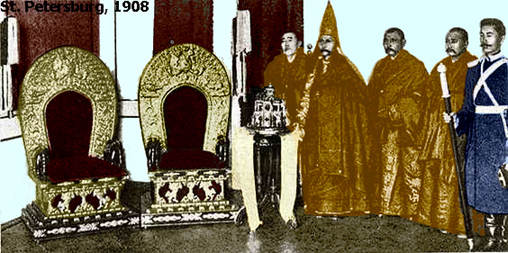 "Buddhism,
as an element of this ethnic identity, has always held a foremost position
in the construction of Kalmyk ethnic identity. When the Kalmyks migrated
to the present Kalmyk areas in the 17th. century, they were observant Buddhists.
A flourishing Buddhist culture developed so that by 1917 there were more
than 100 temples in Kalmykia in which about 3000 clergy lived. In the 1930s
all their lamaseries were closed and destroyed. Thousands of Kalmyks died
in this repression, including lamas; sacred texts, if not salvaged and
buried in private household gardens, were burned. What had been a
magnificent and flourishing Buddhist culture, with grand temples, vast
monasteries, and thousands of lamas was completely destroyed or left
to ruins" (1) "Buddhism,
as an element of this ethnic identity, has always held a foremost position
in the construction of Kalmyk ethnic identity. When the Kalmyks migrated
to the present Kalmyk areas in the 17th. century, they were observant Buddhists.
A flourishing Buddhist culture developed so that by 1917 there were more
than 100 temples in Kalmykia in which about 3000 clergy lived. In the 1930s
all their lamaseries were closed and destroyed. Thousands of Kalmyks died
in this repression, including lamas; sacred texts, if not salvaged and
buried in private household gardens, were burned. What had been a
magnificent and flourishing Buddhist culture, with grand temples, vast
monasteries, and thousands of lamas was completely destroyed or left
to ruins" (1)
(1). Bakaeva, E.P.
Buddism
v Kalmikii
(Buddism in Kalmykia). Elista,
1994, Kalmykia: Kalmitskoe Knizhnoe Izdatelstvo. |


 "Buddhism,
as an element of this ethnic identity, has always held a foremost position
in the construction of Kalmyk ethnic identity. When the Kalmyks migrated
to the present Kalmyk areas in the 17th. century, they were observant Buddhists.
A flourishing Buddhist culture developed so that by 1917 there were more
than 100 temples in Kalmykia in which about 3000 clergy lived. In the 1930s
all their lamaseries were closed and destroyed. Thousands of Kalmyks died
in this repression, including lamas; sacred texts, if not salvaged and
buried in private household gardens, were burned. What had been a
magnificent and flourishing Buddhist culture, with grand temples, vast
monasteries, and thousands of lamas was completely destroyed or left
to ruins" (1)
"Buddhism,
as an element of this ethnic identity, has always held a foremost position
in the construction of Kalmyk ethnic identity. When the Kalmyks migrated
to the present Kalmyk areas in the 17th. century, they were observant Buddhists.
A flourishing Buddhist culture developed so that by 1917 there were more
than 100 temples in Kalmykia in which about 3000 clergy lived. In the 1930s
all their lamaseries were closed and destroyed. Thousands of Kalmyks died
in this repression, including lamas; sacred texts, if not salvaged and
buried in private household gardens, were burned. What had been a
magnificent and flourishing Buddhist culture, with grand temples, vast
monasteries, and thousands of lamas was completely destroyed or left
to ruins" (1)